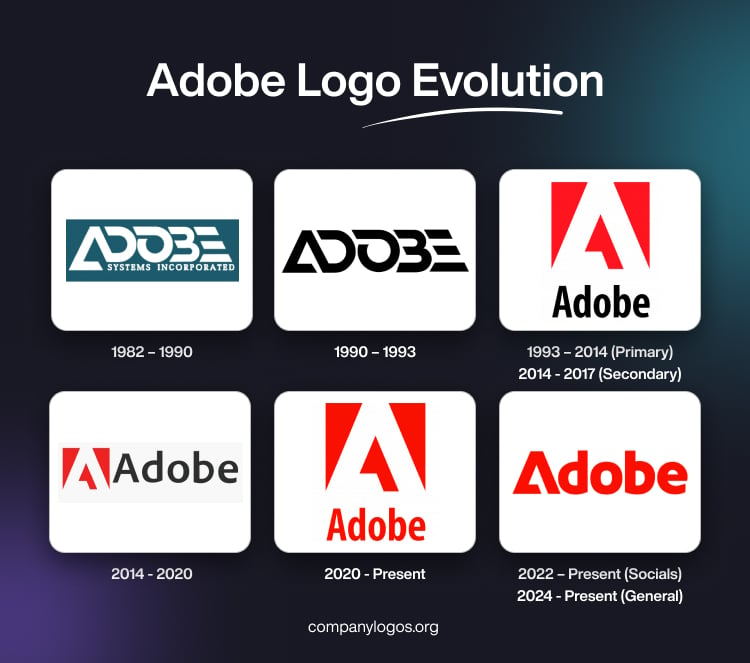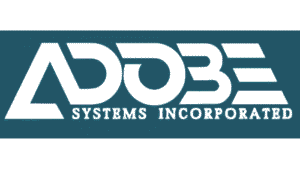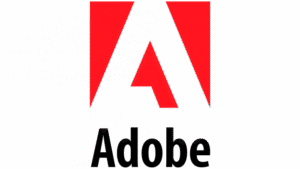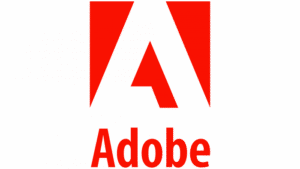
Adobe Inc. is a renowned name in the world of digital creativity and publishing, which is known for its transformative software and technological innovations, such as Photoshop, Flash, Illustrator, Dreamweaver, and others. It started its journey as a Silicon Valley startup and has transformed into a global leader in creative tools. Its success is underpinned by great products, strategic decisions, and an enduring influence on how people create and share digital content.
The Adobe logo has undergone a remarkable transformation since the company’s founding in 1982. Each logo redesign reflects shifts in Adobe’s identity, technological innovation, and its expanding influence in the creative industry. The article delves into the evolution of the Adobe logo and the logos of some of its marquee software products, among other details.
The Genesis of the Adobe Logo (1982 – 1990)
The first Adobe logo was designed by Marva Warnock, wife of co-founder John Warnock. It featured the company name in white, set against a deep teal blue background. The company name was rendered with a custom geometric, modern typography. Here, the capital “A” resembled a triangle with an open base, and the letter “E” was formed of three horizontal bars with diagonal cuts at the ends. Also, beneath the brand name appeared the tagline “Systems Incorporated” in a small Friz Quadrata serif font in uppercase.

(1990 – 1993)
In the early 1990s, Adobe simplified its logo and switched to a black-and-white colour scheme. The brand name was written using a bold, sans-serif font with stylised letters, mostly displayed in a geometric pattern. All other elements were removed to reflect a modern, efficient, and adaptable identity as the company’s software portfolio grew.

(1993 – 2014) (Primary); (2014 – 2017) (Secondary)
The year 1993 marked a key change to the logo. It brought the stylised letter “A” to the forefront, set in white and placed within a bold red square. This “A” was inspired by the shape of Adobe Creek, which ran behind the Warnock home. The wordmark “Adobe” below appeared in black beneath the emblem, using a clean, Myriad Pro Semibold Condensed font. The red square symbolised energy, passion, and innovation, and the simplicity of the logo made it highly recognisable across print and digital media.

(2014 – 2020)
The 2014 logo iteration became more refined, wherein the “A” emblem got more seamlessly integrated with the wordmark. Placed to the right or bottom of the emblem, the more stylish and bold wordmark was rendered in an Adobe Clean Bold Condensed typeface. The letters “d” and “b” of the wordmark looked like mirror images of each other.

(2020 – Present)
Designed by The Acid House, the logo of 2020 saw its colour palette changed from black to red, and the red became brighter. The rest of the logo elements more or less remained the same, with the lines of the letters getting bolder. The typeface chosen for the wordmark remained the same – Adobe Clean Bold Condensed.

(2022 – Present) (Socials); (2024 – Present) (General)
Designed by Mother Design’s in-house team, the 2022 logo variant saw the iconic “A” emblem removed. However, the first letter “A” of the wordmark is replaced with a solid triangular symbol. This resulted in the logo becoming bolder and more modern in appearance. Interestingly, the crossbar in the letter “A” is shifted to the bottom but kept open-ended. This way, the logo subtly takes reference from the original design by Marva Warnock as a nod to Adobe’s heritage. The vibrant red colour of the logo reinforces brand recognition while balancing distinctiveness and legacy.

The Elements of the Adobe Logo
Font
The wordmark used in the Adobe logo is rendered using a modern and stylish sans-serif typeface. The contours of the letters “d” and “b” were interesting and looked like mirror images of each other. Some of the fonts similar to this are FF Pastoral Bold and Diodrum SemiBold.
Colour
The colour palette of the Adobe logo consists of red, white, and black (wordmark) to convey confidence, development, and power.
The History of Adobe
Adobe was founded in December 1982 by John Warnock and Charles Geschke, both former researchers at Xerox Palo Alto Research Centre (PARC). The name of the company was inspired by Adobe Creek, which ran behind Warnock’s home in Los Altos, California. Their initial vision was to develop a page description language that could accurately render text and graphics on printed pages, which ultimately led to the creation of PostScript.
PostScript quickly became the first international standard for computer printing. It revolutionised the publishing industry by enabling precise and device-independent output. Apple recognised its potential and, after an unsuccessful acquisition attempt by Steve Jobs, became a major investor and licensee. This partnership was instrumental in the launch of the Apple LaserWriter printer in 1985. This set in motion the desktop publishing revolution.
The early success of Adobe was fuelled by lucrative licensing deals, with annual revenues reaching $100 million by 1985 and $1 billion by 1990. The company also developed Type 1 digital fonts. However, tensions arose with Apple over font licensing, which led to the so-called “font wars” of the late 1980s. Despite competition, Adobe maintained its leadership by focusing on innovation and expanding its product line.
Adobe began to diversify its offerings by launching and acquiring several key software solutions. For instance, in 1987, it launched Adobe Illustrator, which is a vector graphics editor that became a staple for designers. In 1989, it acquired Photoshop and was launched as an Adobe product in 1990. Soon it became the industry standard for image editing. Between 1991 and 1993, Adobe released the Portable Document Format (PDF) and Adobe Acrobat, which revolutionised document sharing and archiving.
In 1999, Adobe released Adobe InDesign, which eventually replaced PageMaker as the flagship desktop publishing tool. In 2003, it introduced the Adobe Creative Suite, which bundled key applications like Photoshop, Illustrator, and InDesign for the first time. In 2005, Adobe acquired Macromedia and added Flash, Dreamweaver, and other multimedia tools to its portfolio. In 2007, it launched the largest product called Creative Suite 3.
In 2011, Adobe announced the creation of Adobe Creative Cloud and signalled a shift from perpetual software licences to a subscription-based model. In 2013, it discontinued Creative Suite in favour of Creative Cloud. This way, it made all major Adobe software available exclusively via subscription.
Between 2011 and 2020, Adobe stopped the development of Flash for mobile and moved to HTML5. In doing so, it further expanded its suite with tools for digital marketing and analytics. And between 2021 and 2024, Adobe integrated generative AI (notably with Adobe Firefly) to enhance productivity and personalisation across its products.
To Adobe’s credit, its software solutions, such as Photoshop, Illustrator, InDesign, Premiere Pro, Acrobat, and more, have become industry standards for creative professionals, businesses, and educators worldwide. Besides, the PDF format developed by the company is now a universal standard for document exchange.
Based in San Jose, California, Adobe is led by CEO Shantanu Narayen and remains a dominant force in the software industry. It has a market capitalisation that exceeds $160 billion as of 2025. The company’s commitment to creativity, innovation, and responsible AI continues to shape the future of digital experiences.
Interesting Facts About Adobe
- Adobe was founded in December 1982 by John Warnock and Charles Geschke, both former Xerox PARC researchers. The company’s name was adopted from Adobe Creek, which ran behind Warnock’s home in Los Altos, California.
- The original business idea was to develop PostScript, a page description language that revolutionised desktop publishing and printing. In fact, PostScript created by Adobe became the go to standard for magazines and newspapers.
- Adobe’s initial public offering (IPO) took place on August 20, 1986, at a split-adjusted share price of just $0.17.
- Adobe became profitable in its first year, which was a rare feat for a Silicon Valley startup. The achievement was partly due to a substantial investment and licensing deal from Steve Jobs and Apple.
- The iconic Adobe logo was designed by Marva Warnock, John Warnock’s wife, and it features a stylised “A”.
- Adobe acquired Photoshop, its flagship product, in 1989 and launched it in 1990. By 2017, Photoshop had sold over 10 million copies worldwide, thereby making it the most popular image editing software globally.
- Adobe invented the Portable Document Format (PDF) in 1993, which became an international standard (ISO 32000-1:2008). It is now one of the most widely used document formats in the world.
- Adobe has a history of strategic acquisitions, which include Aldus (bringing After Effects), Macromedia (adding Flash and Dreamweaver), and many others.
- The company moved from selling packaged software to a subscription-based model with the launch of Adobe Creative Cloud in 2011. This move transformed its business and made its suite of creative tools more accessible.
- Adobe is a global company headquartered in San Jose, California. It has more than 30,000 employees worldwide as of 2025.
- Adobe’s AI platform, Firefly, has been used to generate over 9 billion images, and more than 400 billion PDFs were opened in Adobe Acrobat in the last year alone.
- Adobe’s stock symbol is ADBE, and it is traded on the NASDAQ.
- Adobe is committed to responsible AI development and transparency. It trains its Firefly models on commercially safe data and drives industry standards through the Content Authenticity Initiative.
Finally
The evolution of the Adobe logo is a visual narrative of the company’s journey of becoming a global software powerhouse. It is rooted in technical precision, driven by creative empowerment, and is ever-adaptive to the changing landscape of design and technology.